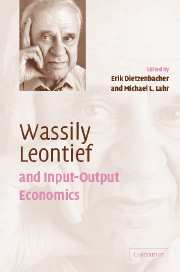Book contents
- Frontmatter
- Contents
- List of contributors
- List of figures
- List of tables
- Preface
- Part I Reflections on input-output economics
- 1 A portrait of the master as a young man
- 2 Leontief's “magnificent machine” and other contributions to applied economics
- 3 Leontief and the future of the world economy
- 4 International trade: evolution in the thought and analysis of Wassily Leontief
- 5 Leontief's input-output table and the French Development Plan
- 6 Leontief and dynamic regional models
- 7 Experiences with input-output and isomorphic analytical tools in spatial economics
- 8 Leontief and Schumpeter: a joint heritage with surprises
- 9 Some highlights in the life of Wassily Leontief – an interview with Estelle and Wassily Leontief
- Part II Perspectives of input-output economics
- Subject index
- Author index
3 - Leontief and the future of the world economy
Published online by Cambridge University Press: 22 September 2009
- Frontmatter
- Contents
- List of contributors
- List of figures
- List of tables
- Preface
- Part I Reflections on input-output economics
- 1 A portrait of the master as a young man
- 2 Leontief's “magnificent machine” and other contributions to applied economics
- 3 Leontief and the future of the world economy
- 4 International trade: evolution in the thought and analysis of Wassily Leontief
- 5 Leontief's input-output table and the French Development Plan
- 6 Leontief and dynamic regional models
- 7 Experiences with input-output and isomorphic analytical tools in spatial economics
- 8 Leontief and Schumpeter: a joint heritage with surprises
- 9 Some highlights in the life of Wassily Leontief – an interview with Estelle and Wassily Leontief
- Part II Perspectives of input-output economics
- Subject index
- Author index
Summary
Historical background
In the 1950s and 1960s the world economy recorded extremely high growth, reaching, on average, an annual gross domestic product (GDP) growth rate of 4.5 percent. This high economic growth raised problems of sustainability, taking into account the increase in pollution and the significant consumption of finite resources such as minerals and hydrocarbons. At the end of the 1960s a thorough analysis of these problems was greatly stimulated by the Club of Rome's active promotion of a world model using systems dynamics methodologies. The model was first developed by Forrester (1971) and expanded by Meadows et al. (1972). The latter study, entitled “Limits to Growth,” pointed quantitatively to the impending dangers of world shortages of energy and raw materials, and to vast environmental problems, should the world population, capital formation, and economic production continue to grow exponentially at rates such as those observed in the preceding decades.
Systems dynamics deals with “multi-loop non-linear feedback systems, a class to which al our social systems belong” (Forrester, 1971, p. 123). The design of the model was fairly simple, the world being treated as a single unit. The structural specification and calibration of the model, however, turned out to be extremely difficult due to a lack of relevant information. As a consequence, arbitrary levels and rates had to be used for most variables. Despite the efforts toward a better quantification by a larger research team, the resulting final world model raised considerable objections.
- Type
- Chapter
- Information
- Wassily Leontief and Input-Output Economics , pp. 30 - 46Publisher: Cambridge University PressPrint publication year: 2004
- 6
- Cited by



